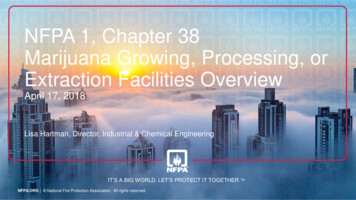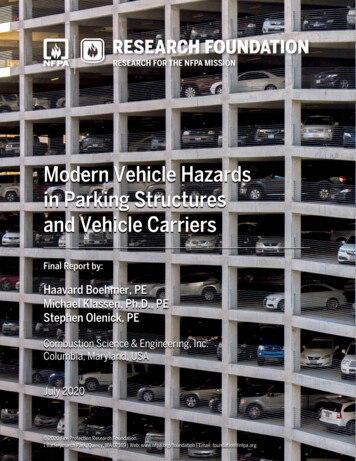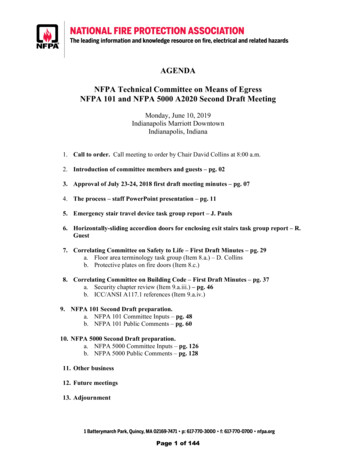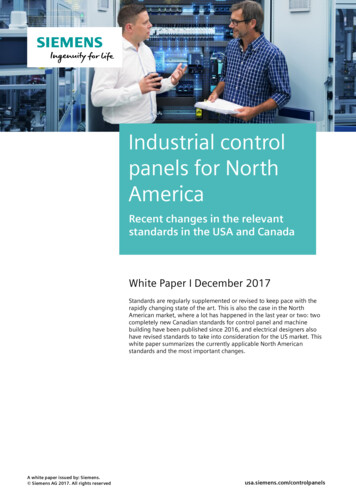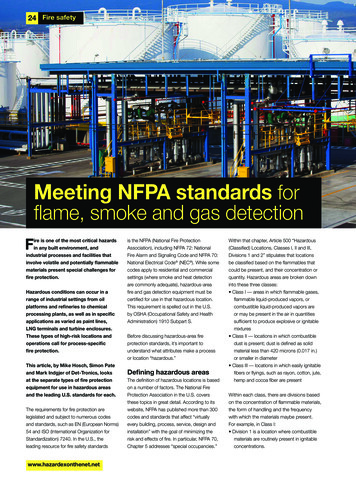![Public Input No. 12-NFPA 497-2014 [ Chapter 2 ]](/img/62/497-a2016-eec-aaa-fd-piresponses.jpg)
Transcription
National Fire Protection Association Report1 of etcher?commentPara.Public Input No. 12-NFPA 497-2014 [ Chapter 2 ]Chapter 2 Referenced Publications2.1 General.The documents or portions thereof listed in this chapter are referenced within this recommended practice and should beconsidered part of the recommendations of this document.2.2 NFPA Publications.National Fire Protection Association, 1 Batterymarch Park, Quincy, MA 02169-7471.NFPA 30, Flammable and Combustible Liquids Code, 2012 edition.NFPA 33, Standard for Spray Application Using Flammable or Combustible Materials, 2011 edition .NFPA 34, Standard for Dipping, Coating, and Printing Processes Using Flammable or Combustible Liquids, 2011 edition .NFPA 35, Standard for the Manufacture of Organic Coatings, 2011 edition .NFPA 36, Standard for Solvent Extraction Plants, 2009 edition 2013 .NFPA 45, Standard on Fire Protection for Laboratories Using Chemicals, 2011 edition .NFPA 55, Compressed Gases and Cryogenic Fluids Code, 2010 edition 2013 .NFPA 58, Liquefied Petroleum Gas Code, 2011 edition 2014 .NFPA 59A, Standard for the Production, Storage, and Handling of Liquefied Natural Gas (LNG), 2009 edition 2013 .NFPA 70 , National Electrical Code , 2011 edition 2014 .2.3 Other Publications.2.3.1 ANSI Publications.American National Standards Institute, Inc., 25 West 43rd Street, 4th Floor, New York, NY 10036.ANSI/ISA-RP12.12.03, Recommended Practice for Portable Electronic Products Suitable for Use in Class I and II, Division 2,Class I, Zone 2 and Class III, Division 1 and 2 Hazardous (Classified) Locations , 2002.2.3.2 API Publications.American Petroleum Institute, 1220 L Street, NW, Washington, DC 20005-4070.API RP 500, Recommended Practice for Classification of Locations for Electrical Installations at Petroleum FacilitiesrdClassified as Class I, Division 1 and Division 2, 2002. (Reaffirmed, November 2002.) 3edition, 2008 .API RP 505, Recommended Practice for Classification of Locations for Electrical Installations at Petroleum FacilitiesClassified as Class I, Zone 0, Zone 1, and Zone 2, 2002, reaffirmed 2013 .2.3. 3 2 ASHRAE Publications.American Society of Heating, Refrigeration and Air-Conditioning Engineers, Inc., 1791 Tullie Circle NE, Atlanta, GA30329-2305.ASHRAE 15 , Safety Code for Mechanical Refrigeration , 2007 & 342013 with 2014 errata ., Safety Standard for Refrigeration Systems ,2.3. 4 3 ASTM Publications.ASTM International, 100 Barr Harbor Drive, P.O. Box C700, West Conshohocken, PA 19428-2959.ASTM D 323, Standard Method of Test for Vapor Pressure of Petroleum Products (Reid Method), 2008.2.3. 5 4 CGA Publications.Compressed Gas Association, 4221 Walney Road, 5th Floor, Chantilly, VA 20151-2923.ANSI/ CGA G2.1, Safety Requirements for the Storage and Handling of Anhydrous Ammonia, 1999.11/26/2014 1:14 PM
National Fire Protection Association Report2 of etcher?commentPara.2.3. 6 5 IEC Publications.International Electrotechnical Commission, 3, rue de Varembé, P.O. Box 131, CH-1211 Geneva 20, Switzerland.IEC TR3 60079-20, Electrical apparatus for explosive gas atmosphere—Part 20: Data for Flammable gaes and vapors,relating to the use of electrical apparatus , 1996.2.-1 , Explosive Atomspheres —Part 20 -1 : Material Characteristics for Gas and Vapor Classification - Test Methodsand Data , 2012 .2.3.6 ISA PublicationsThe International Society of Automation, 67 T.W. Alexander Drive, P.O. Box 12277, Research Triangle Park, NC27709.ISA-RP12.12.03, Standard for Portable Electronic Products Suitable for Use in Class I and II, Division 2, Class IZone 2 and Class III, DIivision 1 and 2 Hazardous (Classified) Locations , 2011 .2. 3.7 Other Publications.Merriam-Webster’s Collegiate Dictionary, 11th edition, Merriam-Webster, Inc., Springfield, MA, 2003.2.4 References for Extracts in Recommendations Sections.NFPA 30, Flammable and Combustible Liquids Code, 2012 edition .NFPA 59A, Standard for the Production, Storage, and Handling of Liquefied Natural Gas (LNG), 2009 edition 2013 .NFPA 70 , National Electrical Code , 2011 edition 2014 .Statement of Problem and Substantiation for Public InputCurrent editions referenced, updated titles of IEC and ISA standards, and eliminated the ANSI section due standard development byIEC.Related Public Inputs for This DocumentRelated InputRelationshipPublic Input No. 13-NFPA 497-2014 [Chapter C]Submitter Information VerificationSubmitter Full Name: Aaron AdamczykOrganization:[ Not Specified ]Street Address:City:State:Zip:Submittal Date:Thu Jun 12 12:34:37 EDT 2014Committee StatementResolution: FR-3-NFPA 497-2014Statement: Current editions referenced, updated titles of IEC and ISA standards, and eliminated the ANSI section due to standarddevelopment by IEC. ASHRAE 34 is not referenced in NFPA 497.11/26/2014 1:14 PM
National Fire Protection Association Report3 of etcher?commentPara.Public Input No. 5-NFPA 497-2014 [ Section No. 2.3.3 ]2.3.3 ASHRAE Publications.American Society of Heating, Refrigeration and Air-Conditioning Engineers, Inc., 1791 Tullie Circle NE, Atlanta, GA30329-2305.ASHRAE 15, Safety Code Standard for Mechanical Refrigeration Systems , 2007 2013 .Additional Proposed ChangesFile Name497 Ferguson ASHRAE PI5-7.pdfDescription ApprovedPI FormStatement of Problem and Substantiation for Public InputThere are outdated references to ASHRAE Standard 15. This proposes to update the reference title and year where it appears in thisstandard.Submitter Information VerificationSubmitter Full Name: STEVEN FERGUSONOrganization:ASHRAEStreet Address:City:State:Zip:Submittal Date:Wed Jan 29 14:13:08 EST 2014Committee StatementResolution: FR-3-NFPA 497-2014Statement: Current editions referenced, updated titles of IEC and ISA standards, and eliminated the ANSI section due to standarddevelopment by IEC. ASHRAE 34 is not referenced in NFPA 497.11/26/2014 1:14 PM
NFPA Public Input FormNOTE: All Public Input must be received by 5:00 pm EST/EDST on the published Public Input Closing Date.FOR OFFICE USE ONLYFor further information on the standards-making process, please contact the Codesand Standards Administration at 617-984-7249 or visit www.nfpa.org/codes.Log #:For technical assistance, please call NFPA at 1-800-344-3555Date Rec’d:DateCompanyNameTel. No.Steve FergusonASHRAEStreet AddressCity2540 Drew Valley RdPlease indicate organization represented (if any)1. (a) Title of ae.orgStateGAZip30319ASHRAENFPA No. & YearNFPA 497497-2012Recommended Practicefor the Classification ofFlammable Liquids, Gases,or Vapors and ofHazardous (Classified)Locationsfor Electrical Installationsin Chemical Process Areas(b) Section/Paragraph2.2.3.3, C2.2Public Input Recommends (check one):new textrevised textdeleted text3. Proposed Text of Public Input (include proposed new or revised wording, or identification of wording to be deleted): [Note:Proposed text should be in legislative format; i.e., use underscore to denote wording to be inserted (inserted wording) and strikethrough to denote wording to be deleted (deleted wording).]2.3.3 ASHRAE Publications. American Society of Heating,Refrigeration and Air-Conditioning Engineers, Inc., 1791 TullieCircle NE, Atlanta, GA 30329-2305.ASHRAE 15, Safety Code Standard for Mechanical Refrigeration Systems, 20072013.C.2.2 ASHRAE Publications. American Society of Heating,Refrigeration and Air-Conditioning Engineers, Inc., 1791 TullieCircle, NE, Atlanta, GA 30329-2305.ASHRAE 15, Safety Code Standard for Mechanical Refrigeration Systems, 20072013.All references to ASHRAE Standard 15 should be editorially corrected from the old title to the new title throughout the document.ExampleFootnote f of Table 4.4.2fFor classification of areas involving ammonia, see ASHRAE 15, Safety Code Standard for Mechanical Refrigeration Systems, andANSI/CGA G2.1, Safety Requirements for the Storage and Handling of Anhydrous Ammonia4. Statement of Problem and Substantiation for Public Input: (Note: State the problem that would be resolved by yourrecommendation; give the specific reason for your Public Input, including copies of tests, research papers, fire experience, etc. If morethan 200 words, it may be abstracted for publication.)There are outdated references to ASHRAE Standard 15. This proposes to update the reference title and year where itappears in this standard
.5. Copyright Assignment(a)I am the author of the text or other material (such as illustrations, graphs) proposed in the Public Input.Some or all of the text or other material proposed in this Public Input was not authored by me. Its source is as(b)follows: (please identify which material and provide complete information on its source)I hereby grant and assign to the NFPA all and full rights in copyright in this Public Input (including both the Proposed Text and the Statement of Problemand Substantiation). I understand that I acquire no rights in any publication of NFPA in which this Public Input in this or another similar or analogous formis used. Except to the extent that I do not have authority to make an assignment in materials that I have identified in (b) above, I hereby warrant that Iam the author of this Public Input and that I have full power and authority to enter into this assignment.Signature (Required)PLEASE USE SEPARATE FORM FOR EACH PUBLIC INPUTTo: Secretary, Standards Council National Fire Protection Association1 Batterymarch Park · Quincy, MA 02169-7471 ORFax to: (617) 770-3500 OR Email to: proposals comments@nfpa.org1/30/2014
National Fire Protection Association Report4 of etcher?commentPara.Public Input No. 20-NFPA 497-2014 [ Section No. 2.3.4 ]2.3.4 ASTM Publications.ASTM International, 100 Barr Harbor Drive, P.O. Box C700, West Conshohocken, PA 19428-2959.ASTM D 323, Standard Method of Test for Vapor Pressure of Petroleum Products (Reid Method), 2008 08(2014) .Statement of Problem and Substantiation for Public InputUpdate the year date for standard(s)Submitter Information VerificationSubmitter Full Name: Steve MawnOrganization:ASTM InternationalStreet Address:City:State:Zip:Submittal Date:Mon Jul 07 12:18:08 EDT 2014Committee StatementResolution: FR-3-NFPA 497-2014Statement: Current editions referenced, updated titles of IEC and ISA standards, and eliminated the ANSI section due to standarddevelopment by IEC. ASHRAE 34 is not referenced in NFPA 497.11/26/2014 1:14 PM
National Fire Protection Association Report5 of etcher?commentPara.Public Input No. 22-NFPA 497-2014 [ Section No. 3.3.4 ]3.3.4 Combustible Liquid.Any liquid that has a closed-cup flash point at or above 100 F (37.8 C), as determined by the corresponding test proceduresand apparatus set forth in Section 4 . 4 of NFPA 30, Flammable and Combustible Liquids Code . Combustible liquids areclassified according to Section 4.3 of NFPA 30. [ 30, 2012] (see 4.1)3.3.4.1 Class II Liquid.Any liquid that has a flash point at or above 100 F (37.8 C) and below 140 F (60 C). [30:4.3.2(1)]3.3.4.2 Class III Liquid.Any liquid that has a flash point at or above 140 F (60 C). [30:4.3.2(2)]3.3.4.3 Class IIIA Liquid.Any liquid that has a flash point at or above 140 F (60 C), but below 200 F (93 C). [30:4.3.2(2)(a)]3.3.4.4 Class IIIB Liquid.Any liquid that has a flash point at or above 200 F (93 C). [30:4.3.2(2)(b)]Statement of Problem and Substantiation for Public InputDefinitions cannot contain references to codes, standards or regulations as they are not enforceable. The information is being placedin the body.Related Public Inputs for This DocumentRelated InputRelationshipPublic Input No. 23-NFPA 497-2014 [Section No. 3.3.6]Public Input No. 24-NFPA 497-2014 [Chapter 4]Submitter Information VerificationSubmitter Full Name: Marcelo HirschlerOrganization:GBH InternationalStreet Address:City:State:Zip:Submittal Date:Mon Jul 07 14:55:16 EDT 2014Committee StatementResolution: The committee has decided to continue to extract the text from NFPA 30 and will follow the guidance of the Flammableand Combustible Liquids Committee.11/26/2014 1:14 PM
National Fire Protection Association Report6 of etcher?commentPara.Public Input No. 14-NFPA 497-2014 [ Sections 3.3.5.1, 3.3.5.2 ]Delete Sections 3.3.5.1 through 3.3.5.2.3 (See accompanying Public Input to place this material in a differentSection)Sections 3.3.5.1 , 3.3.5.23.3.5.1 * Combustible Material (Class I, Division).Class I, Division combustible materials are divided into Groups A, B, C, and D.3.3.5.1.1 Group A.Acetylene.3.3.5.1.2 Group B.Flammable gas, flammable liquid produced vapor, or combustible liquid produced vapor mixed with air that may burn orexplode, having either a maximum experimental safe gap (MESG) value less than or equal to 0.45 mm or a minimum ignitingcurrent ratio (MIC ratio) less than or equal to 0.40. Note: A typical Class I, Group B material is hydrogen.3.3.5.1.3 Group C.Flammable gas, flammable liquid produced vapor, or combustible liquid produced vapor mixed with air that may burn orexplode, having either a maximum experimental safe gap (MESG) value greater than 0.45 mm and less than or equal to 0.75mm, or a minimum igniting current ratio (MIC) ratio greater than 0.40 and less than or equal to 0.80. Note: A typical Class I,Group C material is ethylene.3.3.5.1.4 Group D.Flammable gas, flammable liquid produced vapor, or combustible liquid produced vapor mixed with air that may burn orexplode, having either a maximum experimental safe gap (MESG) value greater than 0.75 mm or a minimum igniting current(MIC) ratio greater than 0.80. Note: A typical Class I, Group D material is propane.3.3.5.2 * Combustible Material (Class I, Zone).Class I, Zone combustible materials are divided into Groups IIC, IIB, and IIA.3.3.5.2.1 Group IIA.Atmospheres containing acetone, ammonia, ethyl alcohol, gasoline, methane, propane, or flammable gas, flammable liquidproduced vapor, or combustible liquid produced vapor mixed with air that may burn or explode, having either a maximumexperimental safe gap (MESG) value greater than 0.90 mm or minimum igniting current ratio (MIC ratio) greater than 0.80.3.3.5.2.2 Group IIB.Atmospheres containing acetaldehyde, ethylene, or flammable gas, flammable liquid produced vapor, or combustible liquidproduced vapor mixed with air that may burn or explode, having either maximum experimental safe gap (MESG) valuesgreater than 0.50 mm and less than or equal to 0.90 mm or minimum igniting current ratio (MIC ratio) greater than 0.45 andless than or equal to 0.80.3.3.5.2.3 Group IIC.Atmospheres containing acetylene, hydrogen, or flammable gas, flammable liquid-produced vapor, or combustible liquidproduced vapor mixed with air that may burn or explode, having either a maximum experimental safe gap (MESG) value lessthan or equal to 0.50 mm or minimum igniting current ratio (MIC ratio) less than or equal to 0.45.Statement of Problem and Substantiation for Public InputThe material contained in the current definition section dealing with Combustible Materials (3.3.5.2.3 through 3.3.5.2.3) does notbelong under Definitions but rather needs to be addressed as done under the NEC as explanatory material. The change presenteddeletes this material in this section and another action places this material into a separate Section, like Section 4 (see other PublicInput) again following the NEC, dealing with combustible material.Submitter Information VerificationSubmitter Full Name: David WechslerOrganization:[ Not Specified ]Street Address:City:State:Zip:Submittal Date:Thu Jun 26 09:41:42 EDT 2014Committee StatementResolution: The committee considers the description of the groups to be definitions, relocation is not permitted by the Manual of Style(1.6.3.1, 1.6.3.2, and 1.6.3.3).11/26/2014 1:14 PM
National Fire Protection Association Report7 of etcher?commentPara.Public Input No. 23-NFPA 497-2014 [ Section No. 3.3.6 ]3.3.6 Flammable Liquid.Any liquid that has a closed-cup flash point below 100 F (37.8 C), as determined by the appropriate test procedures andapparatus set forth in Section 4.4 of NFPA 30 , Flammable and Combustible Liquids Code , and and that has a Reid vaporpressure that does not exceed an absolute pressure of 40 psi (276 kPa) at 100 F (37.8 C), as determined by ASTM D 323,Standard Test Method for Vapor Pressure of Petroleum Products (Reid Method) . Flammable liquids are classified accordingto Section 4.3 of NFPA 30. [ 30, 2012] . (see 4.1).3.3.6.1 Class I Liquid.Flammable liquids , as defined in 3.3.33.2 and 4.2.3 of NFPA 30, Flammable and Combustible Liquids Code , shall be areclassified as Class I liquids and shall be further subclassified in accordance with Sections 3.3.6.2 through 3.3.6.4: [ 30,2012] (see 4.1).3.3.6.2 Class IA Liquid.Any liquid that has a flash point below 73 F (22.8 C) and a boiling point below 100 F (37.8 C) [30: 4.3.1(1)]3.3.6.3 Class IB Liquid.Any liquid that has a flash point below 73 F (22.8 C) and a boiling point at or above 100 F (37.8 C) [30: 4.3.1(2)]3.3.6.4 Class IC Liquid.Any liquid that has a flash point at or above 73 F (22.8 C), but below 100 F (37.8 C) [30: 4.3.1(3)]Statement of Problem and Substantiation for Public InputThis simply moves the references to other documents because definitions cannot contain them.Related Public Inputs for This DocumentRelated InputRelationshipPublic Input No. 22-NFPA 497-2014 [Section No. 3.3.4]Public Input No. 24-NFPA 497-2014 [Chapter 4]Submitter Information VerificationSubmitter Full Name: Marcelo HirschlerOrganization:GBH InternationalStreet Address:City:State:Zip:Submittal Date:Mon Jul 07 14:59:55 EDT 2014Committee StatementResolution: The committee has decided to continue to extract the text from NFPA 30 and will follow the guidance of the Flammableand Combustible Liquids Committee.11/26/2014 1:14 PM
National Fire Protection Association Report8 of etcher?commentPara.Public Input No. 24-NFPA 497-2014 [ Chapter 4 ]Chapter 4 Classification of Combustible Materials4.1 Combustible and flammable liquids criteria4.1.1 Combustible Liquid. Any liquid that has a closed-cup flash point at or above 100 F (37.8 C), as determined by the testprocedures and apparatus set forth in Section 4.4 of NFPA 30, Flammable and Combustible Liquids Code. Combustibleliquids are classified according to Section 4.3 of NFPA 30.4.1.2 Flammable Liquid. Any liquid that has a closed-cup flash point below 100 F (37.8 C), as determined by the testprocedures and apparatus set forth in Section 4.4 ofNFPA 30, Flammable and Combustible Liquids Code, and a Reid vapor pressure that does not exceed an absolute pressureof 40 psi (276 kPa) at 100 F (37.8 C), as determined by ASTM D 323, Standard Test Method for Vapor Pressure ofPetroleum Products (Reid Method). Flammable liquids are classified according to Section 4.3 of NFPA 30.4.1.3 Class I Liquid. Flammable liquids, as defined in 3.3.33.2 and 4.2.3 of NFPA 30, Flammable and Combustible LiquidsCode, shall be classified as Class I liquids and shall be further subclassified in accordance with Sections 4.1.3.1 through4.1.3.3.4.1.3.1 Class IA Liquid. Any liquid that has a flash point below 73 F (22.8 C) and a boiling point below 100 F (37.8 C).4.1.3.2 Class IB Liquid. Any liquid that has a flash point below 73 F (22.8 C) and a boiling point at or above 100 F (37.8 C).4.1.3.3 Class IC Liquid. Any liquid that has a flash point at or above 73 F (22.8 C), but below 100 F (37.8 C).4.2 National Electrical Code Criteria.4.1 2 .1Articles 500 and 505 of the NEC classify a location in which a combustible material is or may be present in the atmosphere insufficient concentrations to produce an ignitible mixture.4.1 2 .2 *In a Class I hazardous (classified) location, the combustible material present is a flammable gas or vapor.4.1 2 .3Class I is further subdivided into either Class I, Division 1 or Class I, Division 2; or Class I, Zone 0, Zone 1, or Zone 2 asdetailed in 4.1.3.1 through 4.1.3.5 .4.1 2 .3.1 Class I, Division 1.A Class I, Division 1 location is a location(1)In which ignitible concentrations of flammable gases, flammable liquid–produced vapors, or combustible liquid–produced vapors can exist under normal operating conditions, or(2)In which ignitible concentrations of such flammable gases, flammable liquid–produced vapors, or combustible liquidsabove their flash points may exist frequently because of repair or maintenance operations or because of leakage, or(3)In which breakdown or faulty operation of equipment or processes might release ignitible concentrations of flammablegases, flammable liquid–produced vapors, or combustible liquid–produced vapors and might also cause simultaneousfailure of electrical equipment in such a way as to directly cause the electrical equipment to become a source of ignition.[70:500.5(B)(1)]4.1 2 .3.2 Class I, Division 2.A Class I, Division 2 location is a location(1)In which volatile flammable gases, flammable liquid–produced vapors, or combustible liquid–produced vapors arehandled, processed, or used, but in which the liquids, vapors, or gases will normally be confined within closed containersor closed systems from which they can escape only in case of accidental rupture or breakdown of such containers orsystems or in case of abnormal operation of equipment, or(2)In which ignitible concentrations of flammable gases, flammable liquid–produced vapors, or combustible liquid–produced vapors are normally prevented by positive mechanical ventilation and which might become hazardous throughfailure or abnormal operation of the ventilating equipment, or(3)That is adjacent to a Class I, Division 1 location, and to which ignitible concentrations of flammable gases, flammableliquid–produced vapors, or combustible liquid–produced vapors above their flash points might occasionally becommunicated unless such communication is prevented by adequate positive-pressure ventilation from a source of cleanair and effective safeguards against ventilation failure are provided.[70:500.5(B)(2)]11/26/2014 1:14 PM
National Fire Protection Association Report9 of etcher?commentPara.4.1 2 .3.3 Class I, Zone 0.A Class I, Zone 0 location is a location in which(1)Ignitible concentrations of flammable gases or vapors are present continuously, or(2)Ignitible concentrations of flammable gases or vapors are present for long periods of time. [70:505.5(B)(1)]4.1 2 .3.4 Class I, Zone 1.A Class I, Zone 1 location is a location(1)In which ignitible concentrations of flammable gases or vapors are likely to exist under normal operating conditions; or(2)In which ignitible concentrations of flammable gases or vapors may exist frequently because of repair or maintenanceoperations or because of leakage; or(3)In which equipment is operated or processes are carried on, of such a nature that equipment breakdown or faultyoperations could result in the release of ignitible concentrations of flammable gases or vapors and also causesimultaneous failure of electrical equipment in a mode to cause the electrical equipment to become a source of ignition;or(4)That is adjacent to a Class I, Zone 0 location from which ignitible concentrations of vapors could be communicated,unless communication is prevented by adequate positive pressure ventilation from a source of clean air and effectivesafeguards against ventilation failure are provided. [70:505.5(B)(2)]4.1.3.5 Class I, Zone 2.A Class I, Zone 2 location is a location(1)In which ignitible concentrations of flammable gases or vapors are not likely to occur in normal operation and, if they dooccur, will exist only for a short period; or(2)In which volatile flammable liquids, flammable gases, or flammable vapors are handled, processed, or used but in whichthe liquids, gases, or vapors normally are confined within closed containers of closed systems from which they canescape only as a result of accidental rupture or breakdown of the containers or system, or as a result of the abnormaloperation of the equipment with which the liquids or gases are handled, processed, or used; or(3)In which ignitible concentrations of flammable gases or vapors normally are prevented by positive mechanical ventilationbut which may become hazardous as a result of failure or abnormal operation of the ventilation equipment; or(4)That is adjacent to a Class I, Zone 1 location, from which ignitible concentrations of flammable gases or vapors could becommunicated, unless such communication is prevented by adequate positive-pressure ventilation from a source ofclean air and effective safeguards against ventilation failure are provided. [70:505.5(B)(3)]4.1 2 .4The intent of Articles 500 and 505 of the NEC is to prevent combustible material from being ignited by electrical equipmentand wiring systems.4.1 2 .5Electrical installations within hazardous (classified) locations can use various protection techniques. No single protectiontechnique is best in all respects for all types of equipment used in a chemical plant.4.1 2 .5.1Explosionproof enclosures, pressurized equipment, and intrinsically safe circuits are applicable to both Division 1 and Division2 locations.4.1 2 .5.2Nonincendive equipment is permitted in Division 2 locations.4.1 2 .5.3 *Portable electronic products (PEPs) meeting the requirements for PEP-1 or PEP-2 of ANSI/ISA-RP12.12.03 RecommendedPractice for Portable Electronic Products Suitable for Use in Class I and II, Division 2, Class I, Zone 2, and Class III, Division 1and 2 Hazardous (Classified) Locations, are considered suitable for use in Division 2 and Zone 2 locations.4.1 2 .5.4Nonsparking electrical equipment and other less restrictive equipment, as specified in the NEC, are permitted in Division 2locations.4.1 2 .6Factors such as corrosion, weather, maintenance, equipment standardization and interchangeability, and possible processchanges or expansion frequently dictate the use of special enclosures or installations for electrical systems. However, suchfactors are outside the scope of this recommended practice, which is concerned entirely with the proper application ofelectrical equipment to avoid ignition of combustible materials.4.1 2 .7For the purpose of this recommended practice, areas not classified as Class I, Division 1; Class I, Division 2: or as Class I,Zone 0, Zone 1, or Zone 2, are “unclassified” areas.4.2 3 Behavior of Class I (Combustible Material) Gases, Vapors, and Liquids.11/26/2014 1:14 PM
National Fire Protection Association Report10 of etcher?commentPara.4.2 3 .1 Lighter-than-Air (Vapor Density Less than 1.0) Gases.These gases tend to dissipate rapidly in the atmosphere. They will not affect as great an area as will heavier-than-air gases orvapors. Except in enclosed spaces, such gases seldom accumulate to form an ignitible mixture near grade level, where mostelectrical installations are located. A lighter-than-air gas that has been cooled sufficiently could behave like a heavier-than-airgas until it absorbs heat from the surrounding atmosphere.4.2 3 .2 Heavier-than-Air (Vapor Density Greater than 1.0) Gases.These gases tend to fall to grade level when released. The gas could remain for a significant period of time, unless dispersedby natural or forced ventilation. A heavier-than-air gas that has been heated sufficiently to decrease its density could behavelike a lighter-than-air gas until cooled by the surrounding atmosphere.4.2 3 .3 Applicable to All Densities.As the gas diffuses into the surrounding air, the density of the mixture approaches that of air.4.2 3 .4 Compressed Liquefied Gases.These gases are stored above their normal boiling point but are kept in the liquid state by pressure. When released, the liquidimmediately expands and vaporizes, creating large volumes of cold gas. The cold gas behaves like a heavier-than-air gas.4.2 3 .5 Cryogenic Flammable Liquids and Other Cold Liquefied Combustible Materials.Cryogenic liquids are generally handled below -150 F (-101 C). These behave like flammable liquids when they are spilled.Small liquid spills will immediately vaporize, but larger spills may remain in the liquid state for an extended time. As the liquidabsorbs heat, it vaporizes and could form an ignitible mixture. Some liquefied combustible materials (not cryogenic) are storedat low temperatures and at pressures close to atmospheric pressure; these include anhydrous ammonia, propane, ethane,ethylene, and propylene. These materials will behave as described in 4.2.1 or 4.2.2 .4.2 3 .6 Flammable Liquids.When released in appreciable quantity, a Class I liquid will begin to evaporate at a rate that depends on its volatility: the lowerthe flash point, the greater the volatility; hence, the faster the evaporation. The vapors of Class I liquids form ignitible mixtureswith air at ambient temperatures more or less readily. Even when evolved rapidly, the vapors tend to disperse rapidly,becoming diluted to a concentration below the lower flammable limit (LFL). Until this dispersion takes place, however, thesevapors will behave like heavier-than-air gases. Class I liquids normally will produce ignitible mixtures that will travel a finitedistance from the point of origin; thus, they will normally require area classification for proper electrical system design.4.2 3 .7 Combustible Liquids.A combustible liquid will form an ignitible mixture only when heated above its flash point.4.2 3 .7.1With Class II liquids, the degree of hazard is lower because the vapor release rate is low at normal handling and storagetemperatures. In general, these liquids will not
NFPA 55, Compressed Gases and Cryogenic Fluids Code, 2010 edition 2013. NFPA 58, Liquefied Petroleum Gas Code, 2011 edition 2014. NFPA 59A, Standard for the Production, Storage, and Handling of Liquefied Natural Gas (LNG), 2009 edition 2013. NFPA 70 , National Electrical Code , 2011 edition 2014. 2.3 Other Publications. 2.3.1 ANSI Publications.
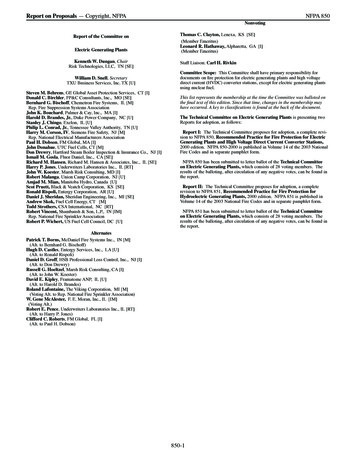
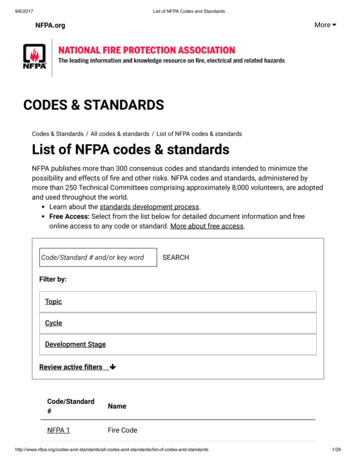
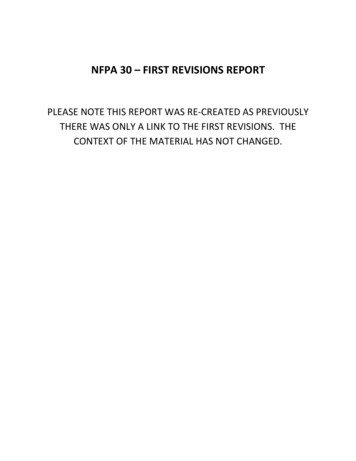
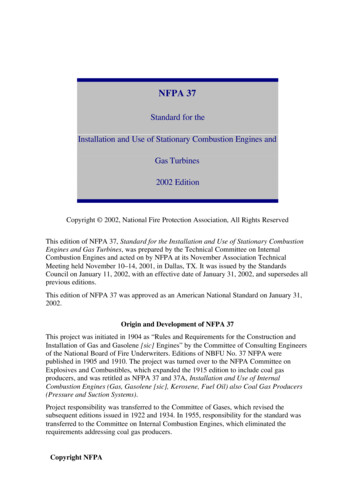
![First Revision No. 10-NFPA 70E-2012 [ Global Input ] Submitter .](/img/64/70e-a2014-frstatements.jpg)
![First Revision No. 8978-NFPA 70-2018 [ Global Input ]](/img/38/70-a2020-nec-p07-fd-frstatements.jpg)
